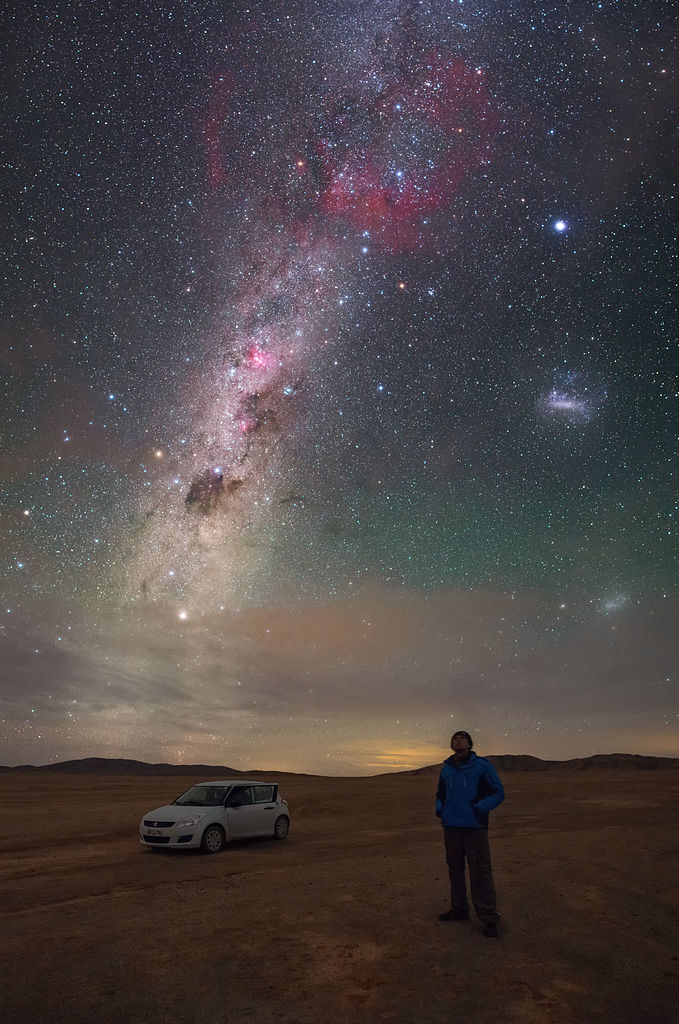http://www.eso.org/public/images/150124_atacama_pano/ wrote:
<<Canopus, also designated Alpha Carinae (α Carinae, abbreviated Alpha Car, α Car), is the brightest star in the southern constellation of Carina, and the second brightest star in the night-time sky, after Sirius. Canopus's visual magnitude is −0.74. Canopus has an MK spectral type of A9 II. The effective temperature of Canopus has been measured to be 6,998 K. Very long baseline interferometry has been used to calculate its angular diameter at 6.9 mas which gives it a radius of 71 R
☉. If it were placed at the centre of the Solar System, it would extend 90% of the way to the orbit of Mercury. Canopus is a source of X-rays, which are probably produced by its corona, magnetically heated to several million K. The temperature has likely been stimulated by fast rotation combined with strong convection percolating through the star's outer layers.
In the Dune universe by Frank Herbert The third planet from Canopus is the desert planet Arrakis (Dune), the only source of the "melange spice", the most important and valuable substance in the universe. Arrakis, with its giant sandworms, its Bedouin-like human inhabitants (the Fremen) clinging to the most precarious of ecological niches through fanatical scrupulousness in water conservation, and its overall concern with ecological themes.
Canopus is over ten thousand times more luminous than the sun. With an
absolute magnitude of −5.71, Canopus is the most intrinsically bright star within approximately 700 light years, and it has been the brightest star in Earth's sky during three different epochs over the past four million years. Other stars appear brighter only during relatively temporary periods, during which they are passing the Solar System at a much closer distance than Canopus. About 90,000 years ago, Sirius moved close enough that it became brighter than Canopus, and that will remain the case for another 210,000 years. But in 480,000 years, Canopus will once again be the brightest.
The name Canopus is a Latinisation of the Ancient Greek name Κάνωβος/Kanôbos, recorded in Claudius Ptolemy's Almagest (c150 AD). Eratosthenes used the same spelling. Hipparchos wrote it as Κάνωπος. John Flamsteed wrote Canobus, as did Edmond Halley in his 1679 Catalogus Stellarum Australium. The name has two common derivations, both listed in Richard Hinckley Allen's seminal Star Names: Their Lore and Meaning:
- One from the legend of the Trojan War, where the constellation Carina was once part of the now-obsolete constellation of Argo Navis, which represented the ship used by Jason and the Argonauts. The brightest star in the constellation was given the name of a ship's pilot from another Greek legend: Canopus, pilot of Menelaus' ship on his quest to retrieve Helen of Troy after she was taken by Paris.
A second from the Egyptian Coptic Kahi Nub ("Golden Earth"), which refers how Canopus would have appeared near the horizon in ancient Egypt, reddened by atmospheric extinction from that position. A ruined ancient Egyptian port named Canopus lies near the mouth of the Nile, site of the Battle of the Nile.
A third is its possible origin from the Semitic root G(C)-N-B (Gimmel-Nun-Beth), from which the Arabic word for south, janūb, is derived. The southeastern wall of the Kaaba in Mecca is aligned with the rising point of Canopus, and is also named Janūb.

In 2014, astronomer Eric Mamajek reported that an extremely magnetically active M dwarf (having strong coronal X-ray emission), situated 1.16 degrees south of Canopus, appears to share common proper motion with the bright star. The projected separation of the M dwarf 2MASS J06234738-5351131 ("Canopus B") is approximately 1.9 parsecs, however despite this large separation, it is still within the estimated tidal radius (2.9 parsecs) for the massive star Canopus.
Before the launch of the Hipparcos satellite telescope, distance estimates for Canopus varied widely, from 96 light years to 1200 light years. Had the latter distance been correct, Canopus would have been one of the most luminous stars in the Milky Way galaxy. Hipparcos established Canopus as lying 310 light years (96 parsecs) from the Solar System; this is based on its 2007 parallax measurement of 10.43 ± 0.53 mas.>>
 Milky Way with Airglow Australis
Milky Way with Airglow Australis
